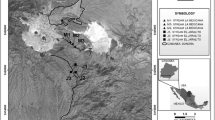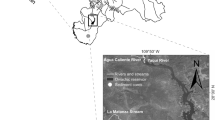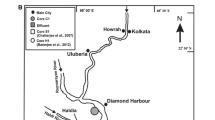Abstract
Geogenic arsenic enrichment in soil and river sediments of Tibet compared to its upper crustal abundance has been observed, raising the question whether other trace elements are also enriched and thus may pose ecological risks. Because human activities are limited, the reservoir sediments after the recent construction of the Shiquan dam on the Singe Tsangpo (ST) and the Zam dam on the Yarlung Tsangpo (YT) collect and thus represent material sourced from 14,870 km2 and 157,668 km2 of drainage areas, respectively. Bulk concentrations of the metalloid (As) and 13 metals (Li, Be, V, Cr, Mn, Fe, Co, Ni, Cu, Zn, Cd, Cs, and Pb) are analyzed for 123 samples from 9 mostly silty sediment cores (depth: 11–20 cm) from the Shiquan Reservoir and for 250 samples from 13 mostly sandy sediment cores (depth: 9–28 cm) from the Zam Reservoir. These elemental concentrations are normalized to the upper crustal Fe abundance of 3.9% to arrive at a regional sediment geochemical background value for each element. The regional background values of most elements in the ST drainage and the YT drainage are comparable with the upper crustal abundance. However, three elements (Li, As, and Cs) in both drainage basins display significant enrichment compared to their respective upper crustal abundance. Sequential leaching of a subset of sediment samples from the ST (n = 18) and YT (n = 29) drainages reveals that chemical fractions of metals and metalloids in these two reservoirs are similar, with most of the elements dominated by the residual fraction with low mobility. Taken together, the ecological risks of the most studied elements in the reservoir sediments are likely low pending further aquatic bioavailability investigations, except that As, Cu, Pb, and Be deserve more attention due to their elevated levels in mobile fractions.






Similar content being viewed by others
Data availability
All data included in this study are available upon request by contacting with the corresponding author.
References
Aloupi, M., & Angelidis, M. O. (2001). Normalization to lithium for the assessment of metal contamination in coastal sediment cores from the Aegean Sea. Greece. Mar. Environ. Res., 52, 1–12. https://doi.org/10.1016/s0141-1136(00)00255-5.
Bibby, R. L., & Webster-Brown, J. G. (2006). Trace metal adsorption onto urban stream suspended particulate matter (Auckland region, New Zealand). Applied Geochemistry, 21, 1135–1151. https://doi.org/10.1016/j.apgeochem.2006.03.014.
Bing, H. J., Zhou, J., Wu, Y. H., Wang, X. X., Sun, H. Y., & Li, R. (2016). Current state, sources, and potential risk of heavy metals in sediments of Three Gorges Reservoir, China. Environmental Pollution, 214, 485–496. https://doi.org/10.1016/j.envpol.2016.04.062.
Blasco, J., Saenz, V., & Gomez-Parra, A. (2000). Heavy metal fluxes at the sediment-water interface of three coastal ecosystems from south-west of the Iberian Peninsula. Science of the Total Environment, 247, 189–199. https://doi.org/10.1016/s0048-9697(99)00490-8.
Cheng, Y. A., & Tian, J. L. (1993). Background values and distribution characteristics of soil elements in Tibet (in Chinese) (p. 69). Beijing: Science.
Duodu, G. O., Goonetilleke, A., & Ayoko, G. A. (2016). Comparison of pollution indices for the assessment of heavy metal in Brisbane River sediment. Environmental Pollution, 219, 1077–1091. https://doi.org/10.1016/j.envpol.2016.09.008.
Edmunds, W. M., Ahmed, K. M., & Whitehead, P. G. (2015). A review of arsenic and its impacts in groundwater of the Ganges-Brahmaputra-Meghna delta, Bangladesh. Environmental Science-Processes & Impacts, 17, 1032–1046. https://doi.org/10.1039/c4em00673a.
Fendorf, S., Michael, H. A., & van Geen, A. (2010). Spatial and Temporal Variations of Groundwater Arsenic in South and Southeast Asia. Science, 328, 1123–1127. https://doi.org/10.1126/science.1172974.
Grimaud, D., Huang, S., Michard, G., & Zheng, K. (1985). Chemical study of geothermal waters of central Tibet (China). Geothermics, 14, 35–48. https://doi.org/10.1016/0375-6505(85)90092-6.
Guan, J. N., Wang, J., Pan, H., Yang, C., Qu, J., Lu, N., & Yuan, X. (2018). Heavy metals in Yinma River sediment in a major Phaeozems zone, Northeast China: Distribution, chemical fraction, contamination assessment and source apportionment. Scientific Reports, 8, 11. https://doi.org/10.1038/s41598-018-30197-z.
Guan, Z. H., Chen, C. Y., Ou, Y. X., Fan, Y. Q., Zhang, Y. S., Chen, Z. M., et al. (1984). Tibetan rivers and lakes (in Chinese). Beijing: Science.
Guo, Q., Wang, Y., & Liu, W. (2007). Major hydrogeochemical processes in the two reservoirs of the Yangbajing geothermal field Tibet China. J. Volcanol. Geotherm. Res., 166, 255–268. https://doi.org/10.1016/j.jvolgeores.2007.08.004.
Guo, Q. H., Planer-Friedrich, B., Liu, M. L., Yan, K., & Wu, G. (2019). Magmatic fluid input explaining the geochemical anomaly of very high arsenic in some southern Tibetan geothermal waters. Chemical Geology, 513, 32–43. https://doi.org/10.1016/j.chemgeo.2019.03.008.
Guo, Q. H., & Wang, Y. X. (2009). Trace element hydrochemistry indicating water contamination in and around the Yangbajing geothermal field, Tibet, China. Bulletin of Environmental Contamination and Toxicology, 83, 608–613. https://doi.org/10.1007/s00128-009-9812-7.
Jiang, J. B., Wang, J., Liu, S. Q., Lin, C. Y., He, M. C., & Liu, X. T. (2013). Background, baseline, normalization, and contamination of heavy metals in the Liao River Watershed sediments of China. Journal of Asian Earth Sciences, 73, 87–94. https://doi.org/10.1016/j.jseaes.2013.04.014.
Karlsson, K., Viklander, M., Scholes, L., & Revitt, M. (2010). Heavy metal concentrations and toxicity in water and sediment from stormwater ponds and sedimentation tanks. Journal of Hazardous Materials, 178, 612–618. https://doi.org/10.1016/j.jhazmat.2010.01.129.
Ke, X., Gui, S., Huang, H., Zhang, H., Wang, C., & Guo, W. (2017). Ecological risk assessment and source identification for heavy metals in surface sediment from the Liaohe River protected area, China. Chemosphere, 175, 473–481. https://doi.org/10.1016/j.chemosphere.2017.02.029.
Lee, P. K., Kang, M. J., Yu, S., Ko, K. S., Ha, K., Shin, S. C., & Park, J. H. (2017). Enrichment and geochemical mobility of heavy metals in bottom sediment of the Hoedong reservoir, Korea and their source apportionment. Chemosphere, 184, 74–85. https://doi.org/10.1016/j.chemosphere.2017.05.124.
Li, C. L., Kang, S. C., Chen, P. F., Zhang, Q. G., Mi, J., Gao, S. P., & Sillanpaa, M. (2014). Geothermal spring causes arsenic contamination in river waters of the southern Tibetan Plateau, China. Environmental Earth Sciences, 71, 4143–4148. https://doi.org/10.1007/s12665-013-2804-2.
Li, C. L., Kang, S. C., Zhang, Q. G., Gao, S. P., & Sharma, C. M. (2011). Heavy metals in sediments of the Yarlung Tsangbo and its connection with the arsenic problem in the Ganges-Brahmaputra Basin. Environmental Geochemistry and Health, 33, 23–32. https://doi.org/10.1007/s10653-010-9311-0.
Li, F., Huang, J. H., Zeng, G. M., Yuan, X. Z., Li, X. D., Liang, J., et al. (2013a). Spatial risk assessment and sources identification of heavy metals in surface sediments from the Dongting Lake, Middle China. Journal of Geochemical Exploration, 132, 75–83. https://doi.org/10.1016/j.gexplo.2013.05.007.
Li, F., Xiao, M. S., Zhang, J. D., Liu, C. Y., Qiu, Z. Z., & Cai, Y. (2018). Spatial distribution, chemical fraction and fuzzy comprehensive risk assessment of heavy metals in surface sediments from the Honghu Lake, China. International Journal of Environmental Research and Public Health, 15, 17. https://doi.org/10.3390/ijerph15020207.
Li, S. H., Wang, M. G., Yang, Q., Wang, H., Zhu, J. M., Zheng, B. S., & Zheng, Y. (2013b). Enrichment of arsenic in surface water, stream sediments and soils in Tibet. Journal of Geochemical Exploration, 135, 104–116. https://doi.org/10.1016/j.gexplo.2012.08.020.
Liu, J., Yao, Z. J., & Chen, C. Y. (2007). Evolution trend and causation analysis of the runoff evolution in the Yarlung Zangbo River Basin. Journal of Natural Resources, 22, 471–477. ((In Chinese with English abstract)).
Lone, S. A., Jeelani, G., Mukherjee, A., & Coomar, P. (2020). Geogenic groundwater arsenic in high altitude bedrock aquifers of upper Indus river basin (UIRB). Ladakh. Applied Geochemistry, 113, 11. https://doi.org/10.1016/j.apgeochem.2019.104497.
Ma, X. L., Zuo, H., Tian, M. J., Zhang, L. Y., Meng, J., Zhou, X. N., et al. (2016). Assessment of heavy metals contamination in sediments from three adjacent regions of the Yellow River using metal chemical fractions and multivariate analysis techniques. Chemosphere, 144, 264–272. https://doi.org/10.1016/j.chemosphere.2015.08.026.
MacDonald, D. D., Ingersoll, C. G., & Berger, T. A. (2000). Development and evaluation of consensus-based sediment quality guidelines for freshwater ecosystems. Archives of Environmental Contamination and Toxicology, 39, 20–31. https://doi.org/10.1007/s002440010075.
Meng, J.L., 2020. Lithium isotopes fraction in the Yarlung Tsangpo River: controlling factors and implications. Master. Thesis. Institute of Geochemistry, Chinese Academy of Sciences (in Chinese).
Newman, B. K., & Watling, R. J. (2007). Definition of baseline metal concentrations for assessing metal enrichment of sediment from the south-eastern Cape coastline of South Africa. Water SA, 33, 675–691.
Palma, P., Ledo, L., & Alvarenga, P. (2015). Assessment of trace element pollution and its environmental risk to freshwater sediments influenced by anthropogenic contributions: The case study of Alqueva reservoir (Guadiana Basin). CATENA, 128, 174–184. https://doi.org/10.1016/j.catena.2015.02.002.
Qin, H., Zhu, J., Li, S., & Wang, M. (2010). Determination of Total Arsenic in Environmental Samples by Hydride Generation-Atomic Fluorescence Spectrometry with PTFE Bomb. Acta Mineralogica Sinica, 30, 398–402. ((In Chinese with English abstract)).
Rahman, M. A., & Hasegawa, H. (2012). Arsenic in freshwater systems: Influence of eutrophication on occurrence, distribution, speciation, and bioaccumulation. Applied Geochemistry, 27, 304–314. https://doi.org/10.1016/j.apgeochem.2011.09.020.
Rasool, A., & Xiao, T. (2018). Distribution and potential ecological risk assessment of trace elements in the stream water and sediments from Lanmuchang area, southwest Guizhou. China: Environmental science and pollution research international. https://doi.org/10.1007/s11356-018-3827-8.
Rieuwerts, J. S., Mighanetara, K., Braungardt, C. B., Rollinson, G. K., Pirrie, D., & Azizi, F. (2014). Geochemistry and mineralogy of arsenic in mine wastes and stream sediments in a historic metal mining area in the UK. Science of the Total Environment, 472, 226–234. https://doi.org/10.1016/j.scitotenv.2013.11.029.
Rudnick, R. L., & Gao, S. (2003). 3.01 - Composition of the Continental Crust. In H. D. Holland & K. K. Turekian (Eds.), Treatise on Geochemistry (pp. 1–64). Oxford: Pergamon.
Schaller, J., Brackhage, C., Mkandawire, M., & Dudel, E. G. (2011). Metal/metalloid accumulation/remobilization during aquatic litter decomposition in freshwater: A review. Science of the Total Environment, 409, 4891–4898. https://doi.org/10.1016/j.scitotenv.2011.08.006.
Schintu, M., Marrucci, A., Marras, B., Galgani, F., Buosi, C., Ibba, A., & Cherchi, A. (2016). Heavy metal accumulation in surface sediments at the port of Cagliari (Sardinia, western Mediterranean): Environmental assessment using sequential extractions and benthic foraminifera. Marine Pollution Bulletin, 111, 45–56. https://doi.org/10.1016/j.marpolbul.2016.07.029.
Sohrin, Y., Matsui, M., Kawashima, M., Hojo, M., & Hasegawa, H. (1997). Arsenic biogeochemistry affected by eutrophication in Lake Biwa, Japan. Environmental Science & Technology, 31, 2712–2720. https://doi.org/10.1021/es960846w.
Soto-Jimenez, M. F., & Paez-Osuna, F. (2001). Distribution and normalization of heavy metal concentrations in mangrove and lagoonal sediments from Mazatlan Harbor (SE Gulf of California). Estuarine Coastal and Shelf Science, 53, 259–274. https://doi.org/10.1006/ecss.2000.0814.
Summers, J. K., Wade, T. L., Engle, V. D., & Malaeb, Z. A. (1996). Normalization of metal concentrations in estuarine sediments from the Gulf of Mexico. Estuaries, 19, 581–594. https://doi.org/10.2307/1352519.
Sun, X. S., Fan, D. J., Liu, M., Tian, Y., Pang, Y., & Liao, H. J. (2018). Source identification, geochemical normalization and influence factors of heavy metals in Yangtze River Estuary sediment. Environmental Pollution, 241, 938–949. https://doi.org/10.1016/j.envpol.2018.05.050.
Sundaray, S. K., Nayak, B. B., Lin, S., & Bhatta, D. (2011). Geochemical speciation and risk assessment of heavy metals in the river estuarine sediments-A case study: Mahanadi basin, India. Journal of Hazardous Materials, 186, 1837–1846. https://doi.org/10.1016/j.jhazmat.2010.12.081.
Sutherland, R. A., & Tack, F. M. G. (2003). Fractionation of Cu, Pb and Zn in certified reference soils SRM 2710 and SRM 2711 using the optimized BCR sequential extraction procedure. Advances in Environmental Research, 8, 37–50. https://doi.org/10.1016/s1093-0191(02)00144-2.
Szolnoki, Z., & Farsang, A. (2013). Evaluation of metal mobility and bioaccessibility in soils of urban vegetable gardens using sequential extraction. Water Air and Soil Pollution, 224, 16. https://doi.org/10.1007/s11270-013-1737-4.
Tam, N. F. Y., & Yao, M. W. Y. (1998). Normalisation and heavy metal contamination in mangrove sediments. Science of the Total Environment, 216, 33–39. https://doi.org/10.1016/s0048-9697(98)00132-6.
Tan, H. B., Su, J. B., Xu, P., Dong, T., & Elenga, H. I. (2018). Enrichment mechanism of Li, B and K in the geothermal water and associated deposits from the Kawu area of the Tibetan plateau: Constraints from geochemical experimental data. Applied Geochemistry, 93, 60–68. https://doi.org/10.1016/j.apgeochem.2018.04.001.
Tariq, J., Ashraf, M., Jaffar, M., & Afzal, M. (1996). Pollution status of the Indus River, Pakistan, through heavy metal and macronutrient contents of fish, sediment and water. Water Research, 30, 1337–1344. https://doi.org/10.1016/0043-1354(95)00300-2.
Verma, S., Mukherjee, A., Mahanta, C., Choudhury, R., Badoni, R. P., & Joshi, G. (2019). Arsenic fate in the Brahmaputra river basin aquifers: Controls of geogenic processes, provenance and water-rock interactions. Applied Geochemistry, 107, 171–186. https://doi.org/10.1016/j.apgeochem.2019.06.004.
Wang, C., Yao, Y., Wang, P. F., Hou, J., Qian, J., Yuan, Y., & Fan, X. L. (2016). In situ high-resolution evaluation of labile arsenic and mercury in sediment of a large shallow lake. Science of the Total Environment, 541, 83–91. https://doi.org/10.1016/j.scitotenv.2015.09.037.
Wang, J., Liu, G. J., Lu, L. L., Zhang, J. M., & Liu, H. Q. (2015). Geochemical normalization and assessment of heavy metals (Cu, Pb, Zn, and Ni) in sediments from the Huaihe River, Anhui, China. CATENA, 129, 30–38. https://doi.org/10.1016/j.catena.2015.02.008.
Xia, P., Meng, X. W., Feng, A. P., Yin, P., Zhang, J., & Wang, X. Q. (2012). Geochemical characteristics of heavy metals in coastal sediments from the northern Beibu Gulf (SW China): the background levels and recent contamination. Environmental Earth Sciences, 66, 1337–1344. https://doi.org/10.1007/s12665-011-1343-y.
Yang, J., Chen, L., Liu, L. Z., Shi, W. L., & Meng, X. Z. (2014). Comprehensive risk assessment of heavy metals in lake sediment from public parks in Shanghai. Ecotoxicology and Environmental Safety, 102, 129–135. https://doi.org/10.1016/j.ecoenv.2014.01.010.
Yang, J. S., Zhang, Z. M., Li, T. F., Li, Z. L., Ren, Y. F., Xu, X. Z., et al. (2008). Unusual minerals from harzburgite, the host rock of the Luobusa chromite deposit. Tibet. Acta Petrologica Sinica, 24, 1445–1452.
Yu, G. B., Liu, Y., Yu, S., Wu, S. C., Leung, A. O. W., Luo, X. S., et al. (2011). Inconsistency and comprehensiveness of risk assessments for heavy metals in urban surface sediments. Chemosphere, 85, 1080–1087. https://doi.org/10.1016/j.chemosphere.2011.07.039.
Yuan, C. G., Shi, J. B., He, B., Liu, J. F., Liang, L. N., & Jiang, G. B. (2004). Speciation of heavy metals in marine sediments from the East China Sea by ICP-MS with sequential extraction. Environment International, 30, 769–783. https://doi.org/10.1016/j.envint.2004.01.001.
Zeng, J., Yang, L. Y., Chuai, X. M., Chen, X. F., Zhao, H. Y., & Wu, Q. L. (2013). Comparison of metal(loid) concentrations in water, sediments and fish from two large shallow lakes. International Journal of Environmental Science and Technology, 10, 1209–1218. https://doi.org/10.1007/s13762-013-0246-8.
Zhang, Q., Tan, H., Zhang, W., Kong, N., & Zhang, Y. (2015). Water environmental effects of Kawu geothermal water in Sajia County. Tibet. Water Resources Protection, 31, 45. ((In Chinese with English abstract)).
Zhang, Y. F., Li, S. H., Zheng, L. R., Chen, J. G., & Zheng, Y. (2017). Evaluation of arsenic sorption and mobility in stream sediment and hot spring deposit in three drainages of the Tibetan Plateau. Applied Geochemistry, 77, 89–101. https://doi.org/10.1016/j.apgeochem.2016.04.006.
Zhao, Z. J., Li, S. H., Xue, L. L., Liao, J., Zhao, J. J., Wu, M., et al. (2020). Effects of dam construction on arsenic mobility and transport in two large rivers in Tibet, China. The Science of the total environment, 741, 140406. https://doi.org/10.1016/j.scitotenv.2020.140406.
Acknowledgements
This work was supported by the National Natural Science Foundation of China (No. 41673137, 41273146); China Geological Survey (No. DD20190534); Shenzhen Science and Technology Innovation Commission (No. JCYJ20170817105912601, GJHZ20180411143520274) and the State Key Laboratory of Environmental Geochemistry (SKLEG2019713). We are very grateful to Hongqiang Gong, Min Guo from Tibet Center for Disease Control and Prevention and Nima from Shiquan River Hydropower Station for their support during sample collection.
Funding
This work was supported by the National Natural Science Foundation of China (No. 41673137, 41273146); China Geological Survey (No. DD20190534); Shenzhen Science and Technology Innovation Commission (No. JCYJ20170817105912601, GJHZ20180411143520274) and the State Key Laboratory of Environmental Geochemistry (SKLEG2019713).
Author information
Authors and Affiliations
Contributions
Zhenjie Zhao helped in resources, formal analysis, writing–original draft, writing–review and editing. Shehong Li developed conceptualization, helped in formal analysis, writing–original draft, writing–review and editing. Lili Xue contributed to resources. Jie Liao helped in resources and formal analysis. Jingjing Zhao contributed to resources. Mei Wu performed formal analysis. Mingguo Wang helped in resources. Qiang Yang contributed to writing–original draft. Jing Sun helped in writing–original draft. Yan Zheng designed conceptualization, carried out formal analysis, helped in writing−original draft, writing−review and editing.
Corresponding authors
Ethics declarations
Conflicts of interest
The authors have no conflicts of interest to declare that are relevant to the content of this article.
Additional information
Publisher's Note
Springer Nature remains neutral with regard to jurisdictional claims in published maps and institutional affiliations.
Supplementary information
Below is the link to the electronic supplementary material.
Rights and permissions
About this article
Cite this article
Zhao, Z., Li, S., Xue, L. et al. Abundance and mobility of metal(loid)s in reservoir sediments of Singe Tsangpo and Yarlung Tsangpo in Tibet, China: Implications for ecological risk. Environ Geochem Health 43, 3213–3228 (2021). https://doi.org/10.1007/s10653-021-00810-8
Received:
Accepted:
Published:
Issue Date:
DOI: https://doi.org/10.1007/s10653-021-00810-8




